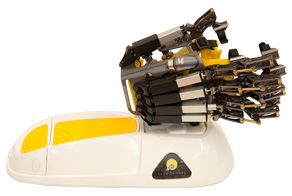Hand of Hope Basics

The hand brace is worn on the dorsal side of the impaired hand with 2 surface sensors attached to the extensor and flexor muscles of the arm to detect the surface electromyographic signals (sEMG) for active participation during exercise. The sEMG signals are processed so the patient can visualise the active movement of the muscle where sEMG electrodes are positioned. No electrical current is applied to the patient.
Intended Use
The Hand of Hope therapy device is intended for use in patients that require hand and forearm rehabilitation. Potential goals for the use of HOH could be, but not limited to the following:
- Motor learning via interactive use of the biofeedback system
- Help initiation of the voluntary muscle contraction and voluntary movement
- Maintain voluntary muscle contraction and the voluntary movement
- To enhance voluntary participation in a rehabilitation setting
Indications
- Decreased muscular activity after Stroke, Spinal Cord Injury, Hand / Finger injury
- Difficulty to self-initiate, control or maintain voluntary muscle movement
- Impaired coordination of voluntary movement of the upper limb
Hand of Hope is used to facilitate:
- Initiation of voluntary muscle contraction
- Motor control and coordination
- Muscle relaxation
- Motivation
- Control of abnormal muscle activity
- Continuous reinforcement of the correct responses
Training Modes
Different training modes allow the therapist to customize the level of assistance that HOH provides. The difficulty level of each mode can be adjusted according to the user’s need.
Continuous Passive Motion
Movements are passively repeated over time. Two CPM patterns are available for training: hand opening & grasping.
EMG Biofeedback Training
Trigger & Go:
The HOH will assist the user in completing the hand motion once the signal is detected above a pre-set sEMG threshold level.
Trigger & Maintain:
The user is required to keep generating a sEMG signal above the pre-set threshold to maintain the assisted hand motion.
Hand Opening Training
The EMG threshold level can be set by moving the horizontal line in the vertically displayed EMG signal bar on the screen. Thereafter the set EMG threshold level is used as a visual biofeedback displayed on the screen. The patient will need to exceed this threshold level in order to run modes of Trigger & Go and Trigger & Maintain.
Open & Grasp Training
Both opening and grasping are performed according to detected EMG threshold. The movement is controlled completely by voluntary muscle contraction.
Training mode is Trigger & Go
Grasping Training
The EMG threshold level can be manually changed depending on the clinician’s observations by moving the horizontal line in the EMG signal bar up and down.
User can select two different training modes:
1. Trigger & Go
2. Trigger & Maintain
Patient Database
Individual patient settings and training details are stored and can be recalled at anytime. Graphical results can be generated within a minute for data analysis.
Forearm Support
The Forearm support is used to provide the patient with a comfortable training experience.



